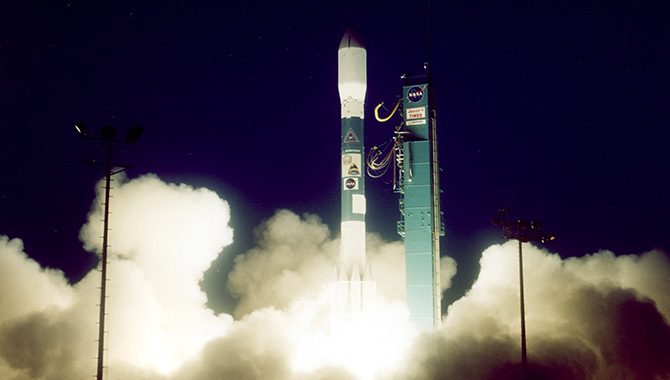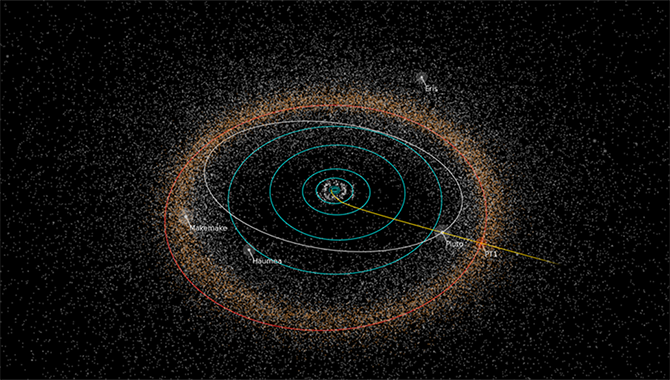
The first-ever 360-degree image of the sun provided by the two STEREO spacecraft, supplemented by data from the Solar Dynamic Observatory.
Credit: NASA/Goddard Space Flight Center/STEREO/SECCHI
Communication interference. Electrical failures. Astronaut hazards. NASA’s STEREO mission offers a unique perspective on solar events that disrupt Earth-based activities.
Once upon a time, humans viewed the sun as a benign yellow disc that hung in the sky. Today, we know that our star is roiling and active, producing flares and coronal mass ejections (CMEs) capable of hurling as much as 10 billion tons of matter toward Earth. These powerful forces trigger magnetic storms that can disrupt a range of human activities, interfering with radio communication and GPS, damaging satellites, prompting power grid outages, and endangering astronauts conducting extra vehicular activities (EVAs). Solar events also impact other planets in the solar system, making them a serious concern for future crewed missions to Mars.
Scientists originally relied on ground-based telescopes to spy flares and CMEs originating from the visible side of the sun. Solar activity on the far side of the star remained a mystery until the sun rotated, often bringing intense eruptions into view that disrupted Earth activities with little warning. To learn more about the origins and behavior of these events, NASA developed the Solar TErrestrial RElations Observatory (STEREO). The third mission in NASA’s Solar Terrestrial Probes (STP) program, STEREO consisted of two nearly identical spacecraft: STEREO Ahead (STEREO-A) and STEREO Behind (STEREO-B). The mission’s primary goal was to examine the cause, structure, and evolution of CMEs and other eruptions on both sides of the sun.
Designing and constructing the STEREO spacecraft was a complicated concern. Each 1,364-pound observatory featured six operational subsystems and carried multiple instruments. Each instrument required a wide field of view and had design requirements that competed with other instruments. The primary instrument package was the Sun Earth Connection Coronal and Heliospheric Investigation (SECCHI), which consisted of four individual instruments: an extreme ultraviolet imager, two white-light coronagraphs, and a single heliospheric imager. In addition, each spacecraft carried an interplanetary radio burst tracker, STEREO/WAVES (SWAVES), which tracked the inception and evolution of radiation disturbances from the sun to the earth; an In-Situ Measurements of Particles and CME Transients (IMPACT) instrument to look at solar energetic particles and the local vector magnetic field; and a Plasma and Suprathermal Ion Composition (PLASTIC) instrument to sample the plasma characteristics of protons, alpha particles, and heavy ions.
On October 25, 2006, STEREO soared into space from Cape Canaveral Air Force Station, Florida, on a Delta II rocket. After deployment, the twin spacecraft set out on separate paths around the sun to deliver different perspectives. STEREO became the first mission to image and track space weather originating from both solar hemispheres. One of the most dramatic examples occurred in August 2010, when STEREO witnessed a period of intense solar activity known as the Great Eruption, during which dozens of flares and shock waves burst from the far side of the star. Barely visible from Earth, STEREO spied the events and sent the images home. Then, six years ago this month, on February 6, 2011, the orbits of STEREO-A and STEREO-B were finally far enough apart to provide the first-ever simultaneous view of both hemispheres of the sun.
Given its novel perspective, the STEREO mission was extended every two years. It continued to send back ground-breaking material until late 2014, when the mission team was faced with a situation that the original spacecraft engineers never considered: a solar conjunction. Nearly eight years after launch, the orbits of the two spacecraft were bringing them close together again. This time, however, STEREO-A and STEREO-B would pass each other on the far side of the sun. As the star came between Earth and the observatories, radio contact would be lost temporarily, a scenario the spacecraft had not been designed to handle. The team decided to place the spacecraft into safe mode as a precautionary measure until contact through the Deep Space Network (DSN) was reestablished.
Before the conjunction, the team conducted a series of tests to ensure the spacecraft would operate as expected under the new circumstances. STEREO-A went first. The tests were successful and the spacecraft entered the first phase of the solar conjunction period without a hitch. Tests for STEREO-B followed. On October 1, 2014, the team initiated a test of the hard command loss timer, which would fire when the spacecraft was out of contact with the DSN. The test proceeded as planned and the spacecraft reset as expected, but the subsequent radio signal was weak, and then it disappeared entirely. The team tried repeatedly to contact STEREO-B but the spacecraft remained silent. Ultimately, the team determined that several aspects of the spacecraft’s attitude control system had failed. This meant the communications antenna no longer pointed toward Earth and the solar array didn’t face the sun, significantly limiting the spacecraft’s ability to communicate or replenish its power.
Each month, the team tried to reestablish contact with STEREO-B through the DSN. Meanwhile, STEREO-A emerged from the solar conjunction and continued sending back valuable data. The mission was again extended, even though only one spacecraft remained operational.
On August 21, 2016, the team heard from STEREO-B again. The signal was quite weak. Nearly two astronautical units (AU) from Earth, the spacecraft was operating on limited power and transmitting little data. For a month, the team tried to get a fix on the spacecraft’s condition so that they could determine how to revive operations. But on September 23, 2016, STEREO-B sent its last signal. It has not been heard from since.
STEREO-A continues to operate normally. It remains a vital aspect of NASA’s Heliophysics Systems Observatory: a collection of missions that observe the sun, producing data that informs spacecraft safety both near and far from Earth. Together with the Solar Dynamics Observatory (SDO) and the joint NASA-European Space Agency (ESA) Solar & Heliospheric (SOHO) project, STEREO-A supports 360-degree observations of the sun for ongoing insight into space weather throughout the inner heliosphere. Meanwhile, the mission team continues to signal STEREO-B, hoping the spacecraft will eventually be recovered.
The STEREO observatories were designed and built by the Johns Hopkins University Applied Physics Lab (APL), which operates the spacecraft. STEREO is managed by Goddard Space Flight Center (GSFC) for the Heliophysics Division of NASA’s Science Mission Directorate (SMD).
Read an APPEL News article about STEREO and space weather.









